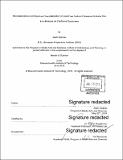Microfabrication and electrical characterization of lead-free sodium potassium niobate thin film ribbons on conformal substrates
Author(s)
Sadraei, Atieh.
Download1136613618-MIT.pdf (8.128Mb)
Other Contributors
Program in Media Arts and Sciences (Massachusetts Institute of Technology)
Advisor
Canan Dagdeviren.
Terms of use
Metadata
Show full item recordAbstract
There have been recent concerns regarding the use, recycling, and disposal of the predominantly used leaded piezoelectric ceramic- Lead Zirconate Titanate (PZT). The European Union has initiated restricting the use of lead in commercial products, with countries such as China and Japan. These regulations provide further motivation for the development of an alternative to leaded piezoelectric materials. The aim of this thesis is to characterize the more recently researched lead-free piezoelectric alternative, Sodium Potassium Niobate (KNN). Thin films of KNN ribbons with gold interconnects are microfabricated on various conformal substrates such as Kapton, Ecoflex, Polydimethylsiloxane (PDMS), and Silbione/fabric and characterized electrically using the Keithley Semiconductor Parameter Analyzer. In this initial experimental evaluation, it was found that at the frequency of 100 KHz, the dielectric constant of the KNN on PDMS is the highest at 427 followed by the Kapton at 410. The Ecoflex and Silbione/fabric both have a dielectric of about 387. In the literature, the dielectric constant of KNN is reported to fall between 185 and 598 based on the substrate it is on, and our values are well within this reported range. The results from the other electrical characterization tests indicate that the KNN behaves similarly on the different tested substrates as the capacitance, polarization curve, and leakage current of all the devices are in the same range and are close as the ribbons are swept from -40 V to 40 V.
Description
Thesis: S.M., Massachusetts Institute of Technology, School of Architecture and Planning, Program in Media Arts and Sciences, 2019 Cataloged from PDF version of thesis. Includes bibliographical references (pages 40-41).
Date issued
2019Department
Program in Media Arts and Sciences (Massachusetts Institute of Technology)Publisher
Massachusetts Institute of Technology
Keywords
Program in Media Arts and Sciences